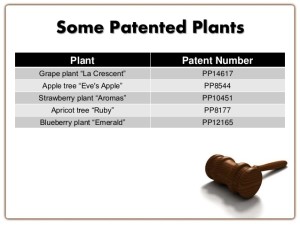 For growers and nurseries, obtaining a plant patent can help to protect an investment, guarantee revenue, and increase brand prestige. Unfortunately, it isn’t always clear when a patent should be obtained and the U.S. Patent and Trademark Office (USPTO) doesn’t exactly make the application process crystal clear. The investment of time and money to obtain a patent may or may not be worth it, but understanding what a patent provides is the first step.
For growers and nurseries, obtaining a plant patent can help to protect an investment, guarantee revenue, and increase brand prestige. Unfortunately, it isn’t always clear when a patent should be obtained and the U.S. Patent and Trademark Office (USPTO) doesn’t exactly make the application process crystal clear. The investment of time and money to obtain a patent may or may not be worth it, but understanding what a patent provides is the first step.
Why Obtain a Plant Patent?
A patent offers legal protection for inventors as a means of ensuring financial gain from investing time and effort into developing a new product. Practically speaking, patents allow breeders the opportunity to set competitive prices on their inventions and charge royalties to anyone wishing to breed or propagate the plant. Patents are also valuable for establishing brand prestige by ensuring that certain cultivars are exclusive to an individual or company.
What Are the Requirements?
A plant patented is granted by the government to anyone who invents a distinct new plant variety. The inventor must be able to demonstrate several facts before the patent is granted, however. Though not an exhaustive list, an inventor must
- Demonstrate that the plant has been produced via asexual reproduction (to ensure that patents are not granted to people for simply planting a seed and growing it),
- Demonstrate that the plant is not a natural cultivar (plants found in nature cannot be patented),
- Show that the plant was not discovered on uncultivated land, and
- Demonstrate that the plant differs in a meaningful way from existing plants (wild varieties cannot be patented, even if they are first discovered on cultivated land).
It is important to note that plants developed through sexual reproduction are not protected under patent law, but can be protected under the federal Plant Variety Protection Act (PVPA). The PVPA gives breeders up to 25 years of control over new and stable sexually reproduced or tuber-propagated plants. This act is often used to protect grains like wheat, barley, and corn.
How to Obtain a Plant Patent
In general, the process of obtaining a patent begins with filing an application. The application is a legal document that requires the following four things.
- Specification – The specification is a complete, detailed account of the plant’s characteristics, relationship to known varieties, antecedents, genetic constitution, etc. expressed in botanical terms.
- Drawings – Drawings are detailed artistic renderings, in color, of the plant and all of its distinctive visual characteristics.
- Inventor’s Oath – The oath is a legally binding testament that the person filing the application is the inventor and that the plant meets the criteria of the Plant Patent provision of 35 U.S.C. 161.
- Specimens – Specimens are not always required, but are often requested. When submitted, specimens may need to represent several stages of the plant’s lifecycle.
The average cost of a patent ranges from $1200 to $6000. Because filing an incomplete patent application or filing one without sufficient fees is grounds for loss of intellectual property rights, most people choose to have a patent attorney handle their invention. The USPTO registers attorneys to practice before it, providing a list of certified patent attorneys for free.
Resources
www.uspto.gov/web/offices/dcom/olia/oed/roster/index.html
http://www.uspto.gov/patents-getting-started/patent-basics/types-patent-applications/general-information-about-35-usc-161#heading-1
http://www.basicpatents.com/patcost.htm
http://www.nolo.com/legal-encyclopedia/plant-patents.html
http://www.uspto.gov/web/offices/pac/mpep/s1601.html

